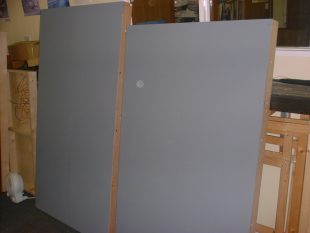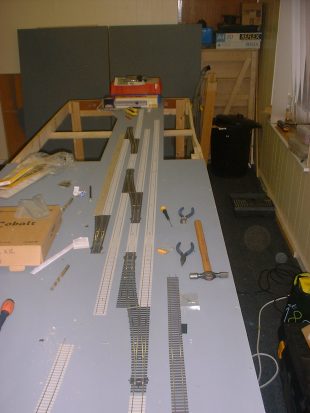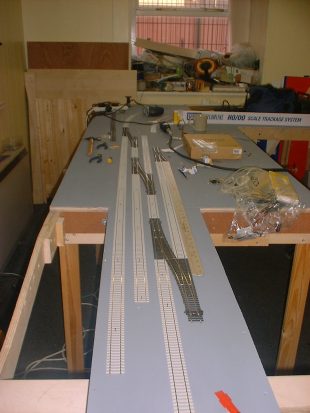by John Wilson
The layout of an area south of Preston station “Bee Lane” had served the club well and had also done sterling service on the exhibition circuit, but time had taken its toll and it was decided to build a new layout. Plans had been drawn up and construction was well underway on a replacement but interest waned and any work on this new layout came to a halt.
In the late summer of 2014 the “00” group had a discussion about what was the future for the new layout and it was evident that no-one wanted to continue with it, so what to proceed with next?
After a few weeks of those interested being given the opportunity to come up with new ideas and, having over the years noticed that at exhibitions customers mainly just want to see trains running, it was agreed that the new layout would be loosely based on an area further south of Bee Lane, comprising of the branch off the main line to Chorley, Bolton and Manchester, for operational interest and, moving a few miles further south to include the station of “Euxton Balshaw Lane”, this new station was opened in 1998 and is located on the two slower lines only.
A distinct advantage of staying within the local area is that any site visits needed to confirm features and take photographs can be made in minutes.
As with the majority of “00” layouts of this size a lot of compromises had to be made to include the various prominent features, so modellers licence came to the rescue.
These features were, starting at the north end of the layout, the M6 motorway bridge, the crossover point work from all four running lines leading off to the Chorley branch with the notorious narrow road bridge on the A49 running under the main line and on to Euxton station which includes a very long ramp for wheelchair, pushchair, bikes etc. to gain access to the south platform.
When the “00” group were satisfied with their plans the proposal was put to the Committee and thankfully this was approved, but the sting in the tail was it had to be presentable (if not completed) for our 2017 exhibition – No pressure then.
When the “00” group were discussing the new layout it was decided that for exhibition use it would be fully DCC and loosely based on the modern image era of the early 2000’s, but whilst in the club rooms it would have to be both DC and DCC.
The project commenced in the beginning of 2015 with the new layout that had been abandoned demolished and as much of the materials as possible being salvaged, work then commenced on building new baseboards, paying special attention to the location of points making sure they were not near any baseboard framing which would interfere with fitting the point motors.

New baseboards constructed – the slightly larger one is for the corner return to the fiddle yard (2 required) – all other boards are of the smaller size (4 required plus one open top baseboard to incorporate the narrow road bridge)

Point work fitted to ensure clearance from timber framing for point motors, the second board of open framework is to accommodate the road bridge under the running lines.

View from opposite end showing open space under the track for low road bridge.
Because of the restriction of available space in the club rooms the length of the layout is only 25ft., for exhibition purposes an extra 5ft. board will be fitted giving a full layout size of 30ft. x 11ft., consideration is being given to add another 5ft. in future years.
Towards the end of 2015 all track had been laid, wired up and tested then ballasted also a few members had started on some of the scenic features which were to be included, these had to be made because the landscaping would have to be constructed with them in-situ.
In March 2016 (12 months off our exhibition) work started on the scenery which will mainly comprise of open countryside as the majority of buildings are well away from the railway but, again, some of the more prominent ones will be included.
One thing that has been noticed is the quickly changing landscape that occurs when building a layout because when we commenced construction trees, bushes, shrubs etc. were very prominent, these have all now been removed also the bungalow that was next the narrow road bridge has been demolished and replaced with a detached house, thank goodness for photographs.
The pictures should explain the method used for creating the scenery and once the top surface has been glued on it becomes a strong structure.




Thick cardboard profiles and then thin card strips interlaced and glued to the profiles.
Various stages of producing the scenery in different areas of the layout, as the saying goes “many hands make light work”


Basic scenery completed with land profile formed – just waiting for top coat of paper before painting and adding foliage.


Left picture showing one of the two catenary masts of this style used the other being on the north side of the platform. The picture on the right showing the method of tensioning the catenary wires – springs fitted to the timber blocks and the wire attached to the springs. The structure either side of the track is just for a small portion of the M6 motorway which will form the scenic break from the layout front to the fiddle yard.
It may be worth noting that whilst constructing the layout it had to be made available for members to use on club nights, the number of occasions when not available for use has been minimal and, the construction crew express there thanks to those members for their understanding on this matter.

Station platforms fitted (Slow lines only) and work started on the surface finishes. Unfortunately one section of track (to the right of the green sand paper) had to be lifted and replaced due to damage, hence the section of track seen with no ballast.


Same location – left picture showing culvert prior to modification but in its location – picture on the right with culvert modified and basic scenery formed to it – again waiting for foliage etc.


Upper picture showing catenary mast in reality, picture on the right in model format.


Upper picture showing cottage framework to see if location suitable before completing the structure. The next few pictures show all elevations of the cottage, with exception of the brickwork and two doors all other elements of the cottage have been made from scratch.



See part 2 here.
